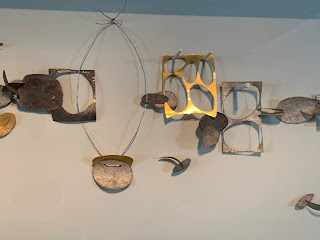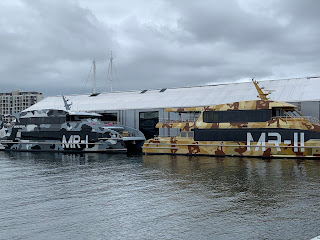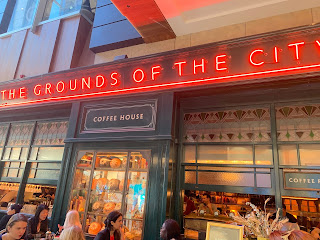Saturday April 6 was another beautiful summer day. High of 28C and sunny. I had my morning coffee at Humanity coffee, at a kiosk not far from the apartment.
 |
| Humanity espresso |
 |
| "Not all who wander are lost, some are just looking for coffee." |
We noted that a number of coffee shops were either closed Saturday or had earlier closing hours (very strange). We then stopped at Coffee Anthology, where we both bought some coffee beans for the trip home and Alain had a flat white.
 |
| Coffee Anthology - they have a variety of good beans |
 |
| Alain waiting for his coffee |
We crossed the Victoria Bridge to the South Bank arts precinct.
 |
| No wind today- crossing the bridge (Alain has the red shoes) |
Our destination was the Gallery of Modern Art (GOMA) which is the Queensland Art Gallery's (QAG) second building. It is the largest gallery of modern and contemporary art in Australia. It complements the QAG, which is only 150 metres away. GOMA opened in 2006. We went to see the
9th Asia Pacific Triennial of Contemporary Art (APT9), which occupied the entire GOMA and part of the QAG.
Before we went into the exhibit, we noticed a piece by Scott Redford (b. 1962) called
The High/Perpetual Xmas, No Abstractions 2008. It exemplifies the 1950s American roadside architectural style called "Googie", which was later adopted in Australia's Gold Coast where Redford grew up.
 |
We loved this piece outside the gallery- not part of the exhibit
Note: In the Lounge: Live from BrizVegas |
We wandered around the gallery a bit and then joined a talk about the highlights of the exhibit, which was excellent. We liked a series of portraits of influential Australians by Vincent Namatjira (b. 1983, Alice Springs), great-grandson of the famous Indigenous Australian landscape artist, Albert Namatjira (1901-1959). We hadn't heard of Albert Namatjira and we asked the guide about him. He filled us in on his importance and his life story.
The top series focuses on the seven Prime Ministers who have governed during Vincent Namatjira's lifetime. The second series features seven senior artists and lawmen who are leaders of the aboriginal communities in South Australia where Namatjira lives. The third series portrays Australia's seven richest people. This is the first time that all three series were shown together. Australians on our tour knew the PM series; knew some of folks shown in the richest series but no one knew any of the aboriginal leaders. Very interesting juxtaposition of the leaders and discussion of power and wealth.
 |
| Prime Ministers series 2016; Seven Leaders series 2016; The Richest series 2016 |
There was an incredible piece by Jonathan Jones untitled (
giran) in collaboration with Dr Uncle Stan Grant Snr that draws on the concept of
giran, which describes the winds, change, as well as fear and apprehension. The flying birds are composed of six tool types, including a bone awl, a wooden spear point, a stone knife, an emu eggshell spool, and a freshwater mussel scraper. The artist worked with the community in gathering feathers and the tools for the piece. It is accompanied by a soundscape. The sounds of wind, bird calls, breathing and Wairadjuri language are part of the piece.
The guide pointed out the infinity shape and the over 2000 sculptures in the piece.
 |
| Guide explaining details of the piece- one of his favourites in the show |
 |
| Infinity shape |
 |
| Stones and feathers- close up |
 |
| Mussel shells |
 |
| Emu shells |
Htein Lin developed his art practice during his incarceration as a political prisoner, when Myanmar was a military dictatorship.
Thabeik Hmauq comprises 108 alms bowls- representing rosary beads- to form an oversized Buddhist rosary. 'Thabeik' is a word for alms bowl and 'Hmauq' is the word for upturn and the phrase has come to denote a boycott or strike. Monks holding alms bowls over their herds was an iconic image of the 2007 Safron Revolution against the military junta.
 |
| Htein Lin-Thabeik Hmauq 2017 |
 |
| Erub/Lifou Project- established 2011. Sea journey: people without borders 2018 |
 |
| Qiu Zhijie (b. 1969 - Zhangzhou, China) Map of Technological Ethics |
 |
| Bounpaul Phothyzan (b. 1979, Laos) Lie of the Land 2017 -empty bombshells used to grow plants |
 |
| Jakkai Siributr (b. 1969) Bangkok - The Singhaseni Tapestries 2017-18 (fabrics are from clothes that his 7 aunts used to wear and the five dresses the exhibit once belonged to his mother- they are embroidered with images from family photos). |
 |
| Sawangwongse Yawnghew (b. 1971 Myanmar, lives and works in Thailand and the Netherlands )- The Myanmar Peace Industrial Complex, Map III 2018 |
There was an amazing piece done with fabric and thousands of steel pins by Aisha Khalid ( b. 1972, Lahore, Pakistan). The three panels were inspired by stitching techniques learnt from her mother.
 |
| Water has never feared the fire 2018 |
 |
| Fish leaving... |
 |
| Back of panel showing the thousands of pins-- and rifle design |
Our guide took us to the second floor and highlighted a piece done by Anne Noble, who is a scientist and a photographer. The photographs were done of bees. There was an actual beehive in the cabinet behind the photos and the beehive was connected to the outside by a Perspex tunnel that allows the bees to come and go as they please. The artist describes this work as a 'living photograph', alive with the hum of busy bees inside.
 |
| Anne Noble (b. 1954 Whanganui, Aotearoa New Zealand) Conversatio: A cabinet of wonder 2018. - The cabinet is opened 4 times a day for 20 minutes so the bees get some light. |
There was a separate room with additional works by Anne Noble called
Museum: For a time when the bee no longer exists. These photos recall dust covered artefacts from another time. Her project deals with the threatened bee. Totally amazing project!!
 |
| View from the Gallery |
There were a number of pieces by Waqas Khan, drawn with a 0.1mm Rapidograph. Incredible amount of time and concentration go into these works.
 |
| Waqas Khan (b. 1982 Akhtarabad Pakistan) The Absence of Paths 2017 |
 |
| Chris Charteris (b. 1966 Auckland) Te ma (Fish Trap) 2014 |
 |
| Enkhbold Togmidshiirev (b.1978 Mongolia) Mother Land 2016 |
 |
| Areta Wilkinson (b. 1969 Kaitaia Aotearoa New Zealand) |
 |
Naiza Khan (b. 1968, Pakistan, lives in Karachi and London,UK). part of 'Heavenly Ornaments' series.
Armour Suit for Rani of Jhansi II |
 |
| We had a break for lunch outside--- excellent salad with corn, kale, and chicken |
We returned to see a few more pieces at GOMA.
 |
| Vuth Lyno (b. 1982 Phnom Penh, Cambodia). House- Spirit 2018 - this piece is made up of over 100 spirit houses (shrines found in homes). He collected these from apartments in an old and well-loved apartment building known as the White Building in Phnom Penh before it was demolished to make room for new buildings. It had been a hub for artists, musicians and performers. Lyno forged close relationship with the community and collected the spirit houses from the residents (either given to him or left behind). |
 |
| Just outside the gallery |
We walked over to the Queensland Art Gallery (QAG) to see some more pieces from the exhibit and also to see some of the permanent collection.
We had wanted to see more work done by Vincent Namatjira and his great-grandfather, Albert Namatjira who our guide had told us were part of the permanent collection of the QAG. Vincent Namatjira's 'Albert's Story' is a series of 13 paintings done in 2014, which deal with the highlights of Albert's life.
 |
| William Dargie painting Albert Namatjira |
 |
| Albert Namatjira receiving Coronation Medal from Her Majesty |
 |
Albert Namatjira in Sydney- Yeah!
|
We then saw the portrait of Albert Namatjira by Willian Dargie done in 1956. In the early 1950s, Dargie had painted with Namatjira in Central Australia and they developed a mutual respect. Namatjira sat for Dargie over the course of a fortnight. After winning the 1956 Archibald Prize at the Art Gallery of New South Wales, the portrait was acquired by the QAG in 1957. It has become accepted as the iconic image of Australia's most recognised Indigenous artist.
 |
| Portrait of Albert Namatjira 1965 |
Albert Namatjira's Western-style landscapes, different from traditional Aboriginal art, made him a celebrated pioneer of contemporary Indigenous Australian art in the 1950s and the most famous Indigenous Australian of his generation. In 1957, Albert Namatjira and his wife Rubina were the first Aboriginal people granted Australian citizenship (our guide said they were only granted certain rights, but not actual citizenship). Yet his life remained heavily controlled. By the end of the 1950s, his family was living in a creek bed on the outskirts of Alice Springs. In 1959, at the age of 57, he died of what his community considered a 'broken heart.'
 |
| Abert Namatjira (1902-1959) The Valley View n.d. |
There was a small area with Vincent Namatjira's Power Portraits.

There were mirrors and various captions hats/ tiaras appeared as one walked by the mirror. We had fun with this.
 |
| "There is a great responsibility involved in national leadership." |
 |
| Queen Elizabeth and her corgis |
We can't overemphasize how much we enjoyed the APT9 exhibit. It was a rare chance to see artists from countries that we are not familiar with. Myanmar, Laos, Cambodia, Mongolia, among others. A lot of very political pieces using very modern technology and materials. A fascinating and creative show.
It was such a beautiful day that we decided to take the free City Hopper Ferry to a spot not far from our apartment.
 |
| Waiting for the ferry |
 |
| Views of some of Brisbane's new buildings |
 |
| The City Hopper ferry coming in to pick us up |
 |
| On the water |
 |
| We passed some interesting sculptures |
 |
| Two modern apartments-- the one on the right had been featured in the Museum of Brisbane |
We decided to have a beer at the very popular Riverbank Bar and Kitchen. We chatted to some folks who had just moved to Brisbane from New Zealand about 7 weeks ago.
 |
| Enjoying our last full day of summer weather |
 |
| Selfie at the Riverbank |
 |
| The Riverbank- very popular |
We passed a very old tree we had seen on our city tour. The sign said, "I am more than 100 years old and still keeping Brisbane clean, green and sustainable."
 |
| Incredible tree |
 |
| Memorial to WWI dedicated on 11 November 1930 |
There is a beautiful church located just a few blocks from the apartment. The light was lovely as we headed back to rest before dinner.
 |
| St. John's Anglican Cathedral |
We went to Gerard's Bistro on James Street in Fortitude Valley. It had a wonderful Middle Eastern menu with Moroccan and Iranian food featuring fresh seasonal produce. It had been recommended to us and we had an excellent dinner.
 |
| Lovely hanging plants - open to the outside |
 |
| Morasa polo, jewelled rice with Iranian fruit, nuts, saffron, orange |
 |
| Charred quail, sweet potato molasses, burnt almond oil |
We also had fried cauliflower, ras el hangout, tahini, pomegranate, with smoked almonds.
 |
| Fabulous flavours- nice Pinot Noir as well |
We shared a desert that they made vegan---- blood plum sorbet, with pistachios and a nitro sahlab made with coconut milk instead of whole milk.
 |
| Wow! |
It was a great finish to our visit to Brisbane. We have really enjoyed the city, which is definitely reinventing itself and making a mark.
We have had an amazing trip to nine locations in NZ and 5 in Oz. We had planned a long trip (10 weeks) thinking it might be our only visit "Down Under." However, we now think that we will return. There are new places to visit and definitely a few we will return to. It was great to experience both large and small centres, the beauty of New Zealand nature and the buzz of the three largest Australian cities. The amazing weather (we only had a very small number of days with a daytime high of less than 20C and very little rain) is a huge draw. We managed to have summer in NZ in February and then early fall in Australia. We would highly recommend a trip to the Southern Hemisphere and have lots of suggestions.
We have also learned about the major food groups: excellent coffee, free range eggs, bacon, avocado toast, grains, wine and beer. Brekkie is a huge meal and is eaten from dawn until 12:30 p.m. Coffee shops close early and dinner is eaten early. Australians shorten their words.
Most major Museums and Galleries are free in both NZ and Australia. The cultural and food scene is very dynamic!!
New Zealander's are really laid back and identify with Canadians i.e. that we both have big neighbours. Tassie is becoming a new tourist destination, especially for Australians, many of whom have never been there. A must go - one of our favourite places.
If we had to pick our top two stays, they would be Queenstown, NZ and Melbourne, Australia. But there were many, many other highlights. We figure we put in around 1.3 million steps each on our Fitbits during our 10 weeks away.
On
Sunday April 7, we flew from Brisbane to Vancouver (just under a 13 hour flight); then a seven hour layover at the airport in Van, and a final 4 hour trip to Toronto. We are in recovery mode now and that is why this last post is a few days late.
 |
| Walking to the train station to catch the Airport express at 7:30 a.m. The sun rose just before 6:00 a.m. Blue, blue sky. |
We want to thank everyone for joining us on this incredible adventure.



































































Comments
Post a Comment